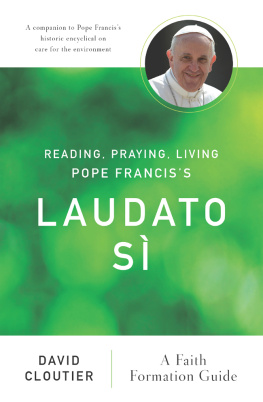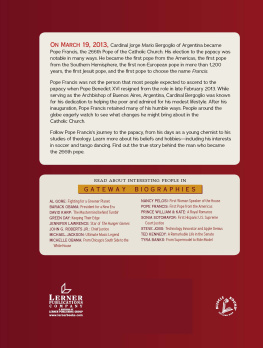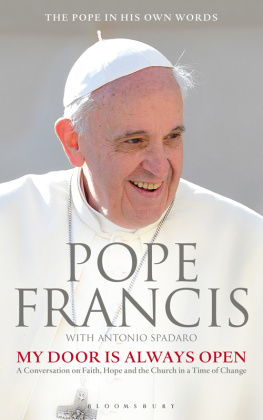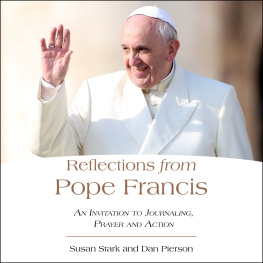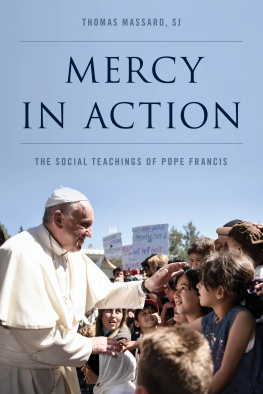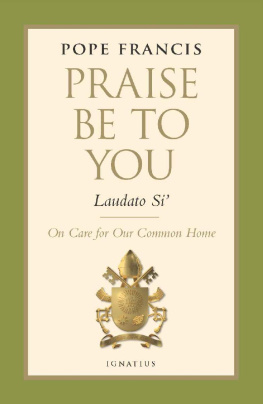Scripture texts in this work are taken from the New American Bible, revised edition 2010, 1991, 1986, 1970 Confraternity of Christian Doctrine, Washington, D.C. and are used by permission of the copyright owner. All Rights Reserved. No part of the New American Bible may be reproduced in any form without permission in writing from the copyright owner.
Excerpts from the English translation of the Catechism of the Catholic Church for use in the United States of America copyright 1994, United States Catholic Conference, Inc.Libreria Editrice Vaticana. English translation of the Catechism of the Catholic Church: Modifications from the Editio Typica copyright 1997, United States Catholic Conference, Inc.Libreria Editrice Vaticana. Used with Permission.
Excerpts from the English translation of The Roman Missal 2010, International Commission on English in the Liturgy Corporation. All rights reserved.
Excerpts from Laudato S 2015, Libreria Editrice Vaticana. All rights reserved. Used by permission.
2015 by Order of Saint Benedict, Collegeville, Minnesota. All rights reserved. No part of this book may be reproduced in any form, by print, micro-film, microfiche, mechanical recording, photocopying, translation, or by any other means, known or yet unknown, for any purpose except brief quotations in reviews, without the previous written permission of Liturgical Press, Saint Johns Abbey, PO Box 7500, Collegeville, Minnesota 56321-7500. Printed in the United States of America.
The Library of Congress has cataloged the printed edition as follows:
Library of Congress Cataloging-in-Publication Data
Cloutier, David M., 1972 author.
Reading, praying, living Pope Franciss Laudato s : a faith formation guide / David Cloutier.
pages cm
Includes bibliographical references.
ISBN 978-0-8146-4754-7 ISBN 978-0-8146-4753-0 (ebook)
1. Catholic Church. Pope (2013 : Francis). Laudato s. 2. Human ecologyReligious aspectsCatholic Church. 3. Ecotheology. 4. Climatic changesEffect of human beings on. 5. Christian sociologyCatholic Church. 6. Catholic ChurchDoctrines. I. Title.
BX1795.H82C38333 2015
261.8'8dc23
2015031263
Contents
Introduction
A papal encyclicalor circular letteris rarely greeted with international attention. An encyclical is the most authoritative teaching document a pope can release. Yet popes issue many of them. Saint John Paul II wrote fourteen. Pope Leo XIII (r. 1878 1903) wrote over eighty, including letters on the rosary and on how to teach philosophy in Catholic schools. Needless to say, these did not make global headlines!
But Pope Leo wrote an encyclical in 1891 called Rerum Novarum, on the new things, and this did capture attention. It spoke out on the pressing social issues of the day: the relationship between workers and big industry and the battle between a ruthless capitalism and a rising socialism. Taking neither side, Leo criticized the excesses of both socialists and capitalists in light of Catholic teaching and natural wisdom. He established principles for both workers and owners, aiming to animate their relationship with the virtues of justice and charity. Rerum Novarum is now seen as the beginning of a special line of social encyclicals, the churchs official response to pressing social crises of the day.
These particular encyclicals receive more attention because they address the wider world. Francis begins Laudato S with the customary references to earlier encyclicals, starting with St. John XXIIIs Pacem in Terris, which was a call for peace as the world was on the verge of nuclear self-destruction in the early 1960s. Francis is signaling how very urgent the environmental crisis is. But Laudato S was highly anticipated for two other reasons.
Major Papal Social Encyclicals
Leo XIII, Rerum Novarum (On Capital and Labor, 1891)
Pius XI, Quadragesimo Anno (On Reconstruction of the Social Order, 1931)
John XXIII, Mater et Magistra (On Christianity and Social Progress, 1961)
John XXIII, Pacem in Terris (On Establishing Universal Peace, 1963)
Paul VI, Populorum Progressio (On the Development of Peoples, 1967)
John Paul II, Laborem Exercens (On Human Work, 1981)
John Paul II, Sollicitudo Rei Socialis (For the Twentieth Anniversary of Populorum Progressio, 1987)
John Paul II, Centesimus Annus (On the Hundredth Anniversary of Rerum Novarum, 1991)
Benedict XVI, Caritas in Veritate (On Integral Human Development, 2009)
It is the first encyclical primarily devoted to the issue of the environmentwhile the topic was addressed in past encyclicals and papal writings, this was the first time the church would lay out the whole picture. Francis begins by noting how Popes Paul VI, St. John Paul II, and Benedict XVI have all spoken with urgency about the environmental crisis, as has the most prominent leader of the Eastern Orthodox Church, Patriarch Bartholomew, whom Francis also cites (49). Indeed, Benedict XVI was called the Green Pope for his attention to this topic and his actions making the Vatican the first carbon-neutral country in the world. But Franciss letter would be the first to go in depth to explain the churchs commitment to Catholics and to all people of goodwill.
It was also the first social encyclical from this rock star Pope Francis, whose outspoken teachings and powerful actions on the topics of social justice and the poor have captured the worlds attention since his election in 2013. Francis has highlighted the need for the church to pay more attention to its teachings about social solidaritythese teachings were clearly stated by previous popes, but did not get the attention they really deserved. Francis is assuring that they are front and center. And even his choice of papal name indicated he was going to challenge people on the environment: St. Francis of Assisis unique perspective led him to a radical simplicity of life and a recognition of even the smallest creatures as brothers and sisters (11)a real challenge to the dream life of accumulation pictured in our advertising!
Because there was so much anticipation (and even a leak a few days before the official release), readers have probably heard something about the encyclical. Thats good, but readers should also be cautious: its a long document that says a lot of things. There is no executive summary. And Francis has a writing style that is more akin to a storyteller stringing together insights and ideas than a professor with a tight textbook presentation.
The Popes Major Points
In paragraph 16, Francis writes he will return again and again to the following themes: the intimate relationship between the poor and the fragility of the planet, the conviction that everything in the world is connected, the critique of new paradigms and forms of power derived from technology, the call to seek other ways of understanding the economy and progress, the value proper to each creature, the human meaning of ecology, the need for forthright and honest debate, the serious responsibility of international and local policy, the throwaway culture and the proposal of a new lifestyle.
This is part of his point: the churchs teaching is not just information, a list of bullet points, or a party platform. It is a spirituality and a way of life. The popes title, Laudato S, means Praise Be, the beginning of St. Franciss hymn praising God for all creatures. And so an actual encounter with the text should not just be about understanding the information and the ideas. It should also be about spiritual development and ethical action. It should change us inside and outside. We not only need to read it; we need to pray it and live it.

